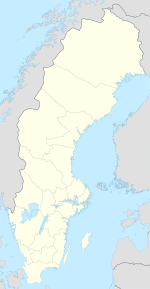King's Grave

The circular burial site near Kivik, Sweden
|
|
| Location | Scania, Sweden |
|---|---|
| Coordinates | 55°41′N 14°14′E / 55.683°N 14.233°ECoordinates: 55°41′N 14°14′E / 55.683°N 14.233°E |
| Site notes | |
| Condition | In ruins |
The King's Grave near Kivik (Kungagraven i Kivik, Kiviksgraven) in the southeastern portion of the Swedish province of Skåne is what remains of an unusually grand Nordic Bronze Age double burial c. 1400 BC.
The site is located about 320 metres (1,000 ft) from the shore of the eastern coast of Scania in southernmost Sweden. In spite of the facts that the site has been used as a quarry, with its stones carried off for other uses, and that it was restored carelessly once it was known to be an ancient burial, these two burials are unique.
In both construction and in size—it is a circular site measuring 75 metres (250 ft) in diameter—this tomb differs from most European burials from the Bronze Age. Most importantly, the cists are adorned with petroglyphs. The images carved into the stones depict people, animals (including birds and fish), ships, lurs being played, symbols, and a chariot drawn by two horses and having four-spoked wheels.
The site was used as a quarry for construction materials until 1748, when two farmers discovered a 3.25 metres (11 ft) tomb, with a north-south orientation, constructed with ten slabs of stone. They dug it out, hoping to find a treasure in the grave.
Soon rumour had it that the two men had found a great treasure in the tomb and the authorities had the men arrested. However, the two men denied having found anything, and as no evidence could be provided against them, they were released.
Several years passed before it was discovered that the slabs of stone in the tomb were adorned with petroglyphs, and a long series of speculations had begun. Still, the quarrying continued and some of the stones disappeared.
The site was excavated by archaeologist (1880–1962) starting in 1931. Between 1931–1933, a thorough excavation was undertaken and the remains of a Stone Age settlement was found under the massive cairn, including a great deal of flintstone shards. Only teeth, fragments of bronze, and some pieces of bone were found, dating from the Bronze Age.
...
Wikipedia

